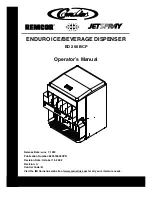
8 | 3MWTS Series Water Softeners – Installation Instructions
3MWTS Series Water Softeners – Installation Instructions | 9
Fig. 2 Top view of the softener and brine tank assembly
BRINE LINE
FITTING
BRINE LINE
BYPASS VALVE
INLET
OUTLET
CONTROL VALVE BODY
DRAIN LINE FLOW
CONTROL ASSEMBLY
BRINE TANK
BRINE WELL
SAFETY BRINE
VALVE ASSEMBLY
BRINE LINE
ELBOW
INJECTOR COVER
OF
F
OF
F
OF
F
OF
F
STEP 7:
Attach drain line to drain line fitting. To prevent back pressure from reducing flow rate below minimum required for backwash, the
drain line must be sized according to run length and relative height. Be careful not to bend flexible drain tubing sharply enough to cause
“kinking” (if kinking occurs drain line must be replaced). Typical examples of proper drain line diameters are:
1. 1/2” ID up to 15 ft. when discharge is lower than inlet.
2. 5/8” ID up to 15 ft. when discharge is slightly higher than the inlet.
3. 3/4” ID when drain is 25 ft. away and/or drain is installed overhead.
Some areas prohibit the use of flexible drain lines. Check your local plumbing code prior to installation.
STEP 8:
Position the drain line over the drain and secure firmly. To prevent back-siphoning of sewer water, provide an air-gap of at least 2” or 2
pipe diameters between end of drain hose and drain (fig. 3). Do not raise drain line more than 10 ft. above floor.
STEP 9:
Connect one end of the included 3/8” black polyethylene tubing to the brine fitting located on the left side of the control valve. Connect
the other end to the safety brine valve elbow inside of the brine well in the brine tank. To do so, remove the retaining clip from the brine
line fitting on the control valve. The retaining clip is holding a plastic insert sleeve and needs to be inserted into the polyethylene tubing
before installing the tubing into the fitting elbow and hand tighten only.
CAUTION:
Do not use pliers or wrenches to tighten as damage
may occur and will void the manufacturer’s warranty.
STEP 10:
Install the overflow line to the brine tank overflow fitting (fig. 2). The overflow discharge must be lower than the overflow fitting. Do not
interconnect overflow line with valve drain line.
STEP 11:
Make certain the bypass valve inlet and outlet knobs are in “bypass” position. After all plumbing connections have been completed,
open main water shut-off valve and restore power to well pump. Check for leaks and correct as necessary.
STEP 12:
Plug the control valve power cord into 110v/60Hz, non-switched power source. Program the control valve (refer to page 10).
NOTE: Regeneration settings for the control valve are factory preset. The control valve design permits adjustment of the salt setting.
This adjustment may be necessary when unusual operating conditions exist, such as high concentrations of iron, manganese or hardness
and/or high flow rates or daily water consumption.
STEP 13:
Manually set the control to backwash position. Press and hold the REGEN button for 3 seconds. The valve will advance to the backwash
position. Unplug power cord to prevent the unit from advancing automatically.
STEP 14:
Partially open the inlet knob on bypass valve (fig. 4). This will allow the unit to fill slowly from the bottom up, reducing air entrapment.
Allow the unit to fill slowly, failure to do so could result in loss of resin to the drain. Once a steady stream of water, with no air sputtering,
is flowing to the drain, the inlet and outlet bypass knobs can be fully opened (refer to fig. 4).
STEP 15:
Plug the power cord back into the power source. Press the REGEN button and wait for the valve to advance to the next regeneration
position. Repeat the process until the valve is in the Service Position (Time of Day will be on the display).
STEP 16:
Refer to Section 3: Control Valve Programming and Regeneration Instructions, on how to set control valve for proper set up and
regeneration settings.
Summary of Contents for 3MWTS Series
Page 22: ......









































